Ask a Jeweler: Shady Platinum, Sizing Up Your Rings, and the Case For Sapphires
by Anna Rasche
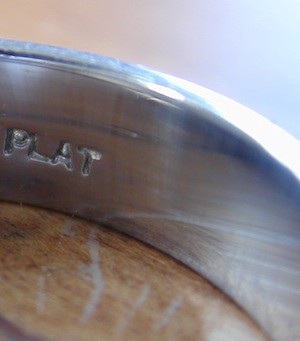
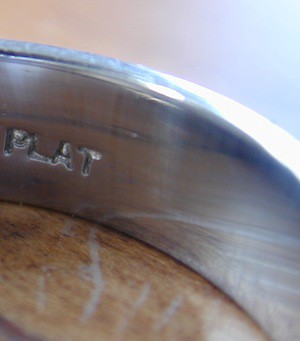
1. My engagement and wedding rings were custom made by a local jeweler in platinum, and have the PLAT marking. I noticed (after over a year of wearing them) that my rings were attracted by a magnet, yet my husband’s platinum band isn’t.
I recently took the rings back to my jeweler to be cleaned, and I intended to ask him, but I chickened out. The rings cost us several thousand dollars, and the jeweler gave us a valuation certificate when we bought them. Should I be worried?
Don’t worry, your jeweler is legit! Here’s why:
One hundred percent pure platinum is too soft to be used in jewelry, so to make it durable enough for everyday wear, platinum has to be mixed (or alloyed) with another metal. Same goes for gold and silver, by the way. Most platinum jewelry made in the United States these days is 95 percent platinum and 5 percent some other metal (although it’s not uncommon to see different ratios). In your case, I’m guessing the 5 percent Something Else is cobalt, which would make the whole ring magnetic. Platinum/cobalt alloys are often used for casting detailed pieces (like an engagement ring with prong settings).
Your husband’s ring is likely made with a different platinum alloy, probably iridium, which is not magnetic. Platinum/iridium is more commonly used for fabrication work (like taking a piece of platinum wire and then shaping it into a simple band).
Hopefully that put your mind at ease, but in the future don’t be a chicken about asking your jeweler! The PLAT stamp and the valuation he gave you are guarantees of your purchase. If you are worried you bought something on the pretense of incorrect information, it’s his job to fix the problem ASAP. Any honest jeweler will be happy to oblige.
***2. My wedding band was my husband’s grandmother’s, and has small channel-set (I think?) diamonds all the way around a white gold band. What’s not so small? My finger. I wear the band now, but honestly, getting it off takes patience and lots of tugging and sometimes soap, so I’d really like to size it up a little bit.
However, the internet seems to have lots of conflicting advice ranging from “you can’t do it, you’ll destroy the ring” to “you can do it, but only within certain parameters” to “just lose weight, fattie!” (that last one’s not so helpful).
So is it possible to increase the size of my ring? Are there certain questions I need to ask/things I need to look for to be sure a jeweler will do it correctly? Or do I just leave it where it is and hope I never need to remove it in an emergency?
I hear this one a lot. Essentially, the person who told you, “You can do it, but only within certain parameters,” is correct. Also, just to clear things up, channel-setting looks like this:
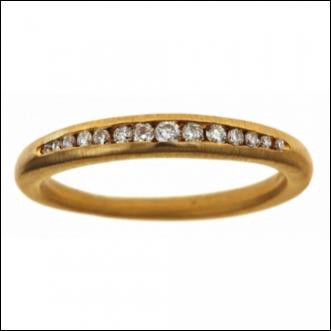
Ring by Conroy and WilcoxThe normal way to make a ring larger is to cut it open, widen the gap, and then insert more metal. Of course, this is not possible to do with channel-set eternity bands because changing the circumference of the ring will mess up all the little spaces the stones live in, and then they fall out or get crunched and everyone gets sad. However, if the ring is only a tiny bit too small for you and if the stones are set up high in the ring (meaning there is some space between the bottom of the stones and the inside edge of the metal band), it’s possible for a jeweler to grind down the inside and slightly increase the size of the finger opening.
If that’s not an option for you ring, I’d see about getting the stones re-set in a band that fits you more comfortably. Finger claustrophobia is never fun.
***3. I’m sure you get all sorts of variations of the I-don’t-want-a-diamond-but-what-do-I-want question from us kids who read The Hairpin regularly and who are looking into ways to have their significant others serve up their love without a side of blood. But seriously, what do I want if I don’t want a diamond? Do I want a sapphire? Do I want something lab-created? Where do I find it? What do I look for? The purple ones are GORGEOUS but stupid expensive. Is blue the only answer for sapphires? What are other gemstone options?
Also, what do I do if my above questions are moot because I really want an opal engagement ring? What if it’s the only thing I’ve ever wanted in my life, but I’ve read way too much about them breaking/chipping/falling-out to spend a significant amount of money on them? Do you possess some sort of magic that would prevent any of those tragedies from taking place? Do you know a jeweler that does?
I feel like Love With a Side of Blood is a Lifetime Original waiting to happen. In all seriousness, though, if you want to get an ethically-sourced engagement ring, you have to go way deeper than just avoiding diamonds. Mining operations that focus on other gemstones and precious metals are often guilty of the same environmental degradation and human rights violations as diamond mines. The best way to avoid supporting these dubious enterprises is to buy estate pieces or pieces from vendors that use only recycled, ethically sourced, or lab-grown materials. Luckily, lots of companies are starting to offer products that fall under these parameters. Brilliant Earth is one of the bigger guys, but lots of small-scale artists are starting to use ethically sourced materials as well. Anywayyy, this is a big topic that I could go on about all day but you asked about…
Sapphires!
Sapphires are a great choice for engagement rings because they are very durable and come in all colors of the rainbow.
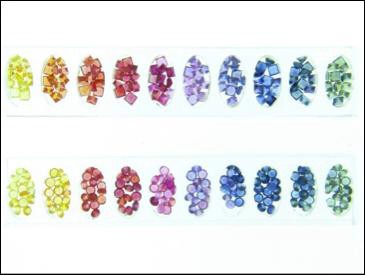
Sapphires from Exceptional GemsSapphires and rubies are actually the same exact species of gemstone (corundum). The only difference is that when corundum is red it’s called a ruby, and when it’s any other color it’s called a sapphire. Sapphires can be found in lots of vintage pieces, and are also super affordable if they are lab-grown (a.k.a. synthetic). “Synthetic” carries some negative connotations, but lab-grown stones are chemically identical to natural ones and even a trained gemologist will have to do some scrutinizing under magnification to tell a natural stone from a synthetic.
In researching your question I called up Kaye, Zales, and Jared’s and they all said they could get me a “lab-created” sapphire if I wanted. Not that I would recommend shopping at those places if you can help it — Kay commercials make me throw up in my mouth a little — but it confirmed that synthetics are easily available all over the place. You just have to ask! I’m not sure where you were looking, but even “the purple ones” will be a tiny fraction of the cost of natural sapphires. Color doesn’t make much of a price difference when it comes to synthetic corundum.
Other nice sparkly gems that come in all sorts of colors are tourmalines and garnets. Bonus points for tourmaline: a lot of really nice ones are mined in Maine, so you can buy those to avoid human rights issues.
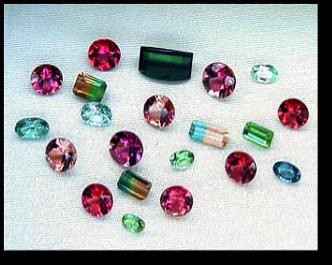
Maine tourmalines from Mt. Mica RaritiesBut this is all moot, really, because you love Opals. People have told you to forget this love because opals are too delicate, but you can’t choose who you fall in love with and there are a few options that can make opal engagement rings a plausible choice.
1. Use the design of your ring to protect the opal. I would recommend a bezel setting (a bezel is a strip of metal that goes all the way around a stone) where the opal doesn’t stick out too far past the metal.
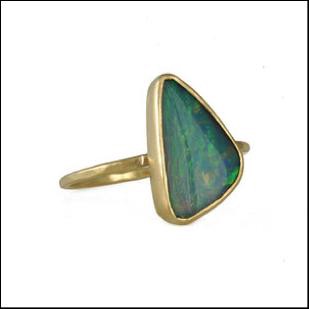
Opal ring by Melissa Joy Manning2. You could buy an opal triplet. Since opal is fragile and can be expensive, sometimes people take a thin opal slice and sandwich it between a stable backing and a clear quartz cap (take away the quartz cap and it’s called an opal doublet). It’s hard to notice the difference between a doublet/triplet and a solid opal once they’re set in jewelry, but when you look at a loose stone in profile it’s quite obvious to the eye. Triplets are very inexpensive (like, $5 — $20), so typically people don’t use them in fine jewelry, but don’t let the haters stop you. (Also note that, if possible, you should avoid taking these assembled stones in water, as the adhesive can eventually weaken.)
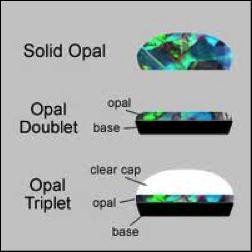
Diagram from geology.com3. Boulder opal! Sort of like nature’s opal doublet, boulder opal happens when thin sheets of opal form in the cracks of rocks. The opal is so thin, that when people cut it they leave some of the “boulder” on the back of the stone, which increases durability.
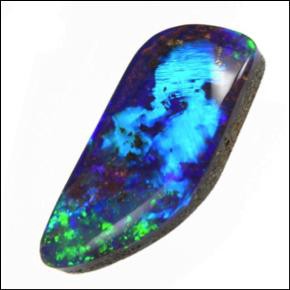
Boulder Opal from Opal DirectSince most opals are mined in Australia, they are yet another good, ethically-sourced, gemstone option.
Previously: Ask a Jeweler: Nonmetal Bands, Gem Appraisal, and Inherited Damage
Top photo via eastpole/flickr.
Anna Rasche works in the Diamond District by day, and helps run the Society for the Advancement of Social Studies by night. She enjoys good cheese and bad puns. Ask her anything.